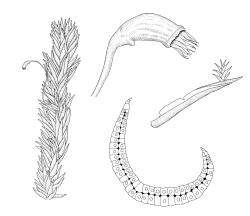Plants medium-sized to robust, pale- or white-green, forming dense cushions or tufts. Stems erect, mostly forked, in cross-section lacking (usually) or with a central strand, rhizoids usually sparse. Leaves erect, spreading, or secund, narrowly to broadly lanceolate from a ± oblong or elliptic base, rarely auriculate, ± subtubulose above, mostly acute, entire or denticulate near apex, often scabrous abaxially near apex by protruding cell ends. Lamina restricted to leaf base, consisting of 1–c. 20 rows of dead cells (hyalocysts) on either side of the costa. Alar cells not differentiated (but leaves sometimes auriculate at base). Costa broad and occupying nearly all of the leaf, at mid leaf and above consisting of a single layer of subquadrate chlorophyllose cells (chlorocysts) enclosed both abaxially and adaxially by one or more layers of large dead cells (hyalocysts) that are connected by conspicuous pores, in the alar region often with multiple layers of hyalocysts. Deciduous leaves often present at stem tips.
Pseudautoicous. Perichaetia lateral or terminal. Dwarf male plants in the tomentum or on leaves of female plants. Setae single, elongate; capsules inclined, asymmetric, sulcate when dry, often strumose; stomata none; annulus mostly lacking; operculum long-rostrate. Peristome teeth 16, lanceolate, bifid ± halfway, vertically striolate below, papillose above. Calyptra cucullate. Spores spherical.
Leucobryum is a large and taxonomically difficult genus widely distributed in tropical and temperate regions. Recent regional treatments (e.g., Enroth 1990 for part of Papua New Guinea; Eddy 1990 for Malesia; Yamaguchi 1993 for Asia; Peterson 1994 for Mexico; and Klazenga 2012 for Australia) have reduced substantial numbers of described names to synonymy. The past description of large numbers of regional variants as species and lack of consensus concerning taxonomic limits make an estimate of the size of the genus impractical.
The layers of large, non-chlorophyllose cells interconnected by pores in this genus are in many ways suggestive of the structure of Sphagnum leaves. The pores of Leucobryum are not “ringed” as they are in many species of Sphagnum, nor do they open to the surface of the cell. The pores of Leucobryum are easily seen in both surface view and in costal cross-section with a compound microscope. In Leucobryum the photosynthetic cells (chlorocysts) are restricted, in the upper leaf, to a single layer that is covered both abaxially and adaxially by one or more layers of dead cells (hyalocysts). In Sphagnum, by contrast, the leaf is only a single layer thick and the living and dead cells form a net-like reticulation. The pores in Leucobryum probably facilitate water absorption and storage.
| Category | Number |
|---|---|
| Indigenous (Non-endemic) | 1 |
| Total | 1 |
Leucobryum speirostichum Müll.Hal. nom. nud. [Genera Musc. Frond. 80, 1900] was cited as a synonym of L. candidum var. pentastichum (Dozy & Molk.) Dixon by Dixon (1923, p. 97). The basionym of the latter is based on a Javanese collection by Junghuhn and in turn was considered a heterotypic synonym of L. javense by Enroth (1990). Six specimens in the Beckett herbarium, determined by Müller and by Brotherus, do not differ significantly from other Australasian L. javense, and this name is therefore not considered further here.
Leucobryum interruptum Müll.Hal. [Genera Musc. Frond. 81, 1900] is a nom. nud. It was placed in the synonymy of L. candidum by Dixon (1923, p. 97). Fragmentary "type" material is present in the Beckett herbarium at CHR (622475!).
Leucobryum spinidorsum Müll.Hal. [Hedwigia 36: 331, 1897] is based on Tasmanian and N.Z. syntypes, the latter collected by C. Fristedt at "Whangarou" [probably Whangaroa]. Dixon (1923, p. 97) put this name in the synonymy of L. candidum. I have not seen type material.





